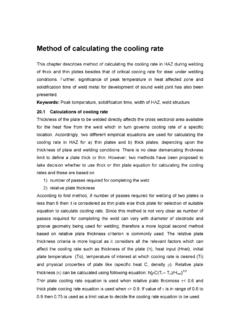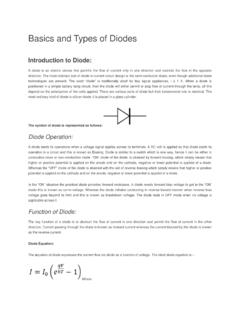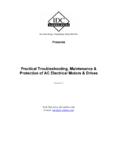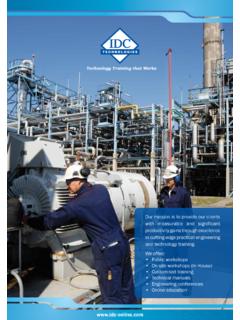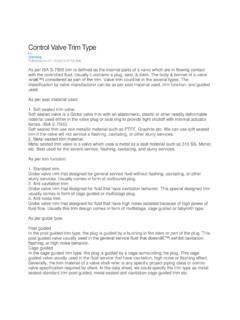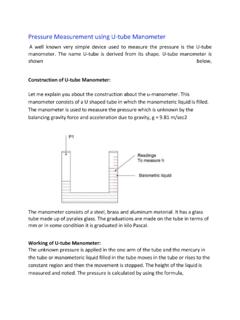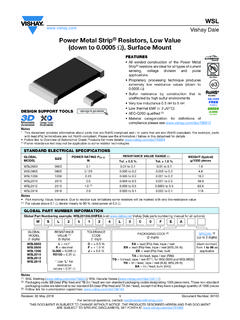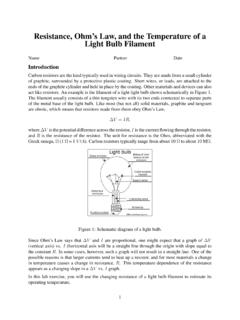Transcription of Introduction - idc-online.com
1 Introduction Temperature sensors are vital to a variety of everyday products. For example, household ovens, refrigerators, and thermostats all rely on temperature maintenance and control in order to function properly. Temperature control also has applications in chemical engineering. Examples of this include maintaining the temperature of a chemical reactor at the ideal set-point, monitoring the temperature of a possible runaway reaction to ensure the safety of employees, and maintaining the temperature of streams released to the environment to minimize harmful environmental impact. While temperature is generally sensed by humans as hot , neutral , or cold , chemical engineering requires precise, quantitative measurements of temperature in order to accurately control a process.
2 This is achieved through the use of temperature sensors, and temperature regulators which process the signals they receive from sensors. From a thermodynamics perspective, temperature changes as a function of the average energy of molecular movement. As heat is added to a system, molecular motion increases and the system experiences an increase in temperature. It is difficult, however, to directly measure the energy of molecular movement, so temperature sensors are generally designed to measure a property which changes in response to temperature. The devices are then calibrated to traditional temperature scales using a standard ( the boiling point of water at known pressure).
3 The following sections discuss the various types of sensors and regulators. Temperature Sensors Temperature sensors are devices used to measure the temperature of a medium. There are 2 kinds on temperature sensors: 1) contact sensors and 2) noncontact sensors. However, the 3 main types are thermometers, resistance temperature detectors, and thermocouples. All three of these sensors measure a physical property ( volume of a liquid, current through a wire), which changes as a function of temperature. In addition to the 3 main types of temperature sensors, there are numerous other temperature sensors available for use. Contact Sensors Contact temperature sensors measure the temperature of the object to which the sensor is in contact by assuming or knowing that the two (sensor and the object) are in thermal equilibrium, in other words, there is no heat flow between them.
4 Examples (further description of each example provide below) Thermocouples Resistance Temperature Detectors (RTDs) Full System Thermometers Bimetallic Thermometers Noncontact Sensors Most commercial and scientific noncontact temperature sensors measure the thermal radiant power of the Infrared or Optical radiation received from a known or calculated area on its surface or volume within it. An example of noncontact temperature sensors is a pyrometer, which is described into further detail at the bottom of this section. Thermometers Thermometers are the most common temperature sensors encountered in simple, everyday measurements of temperature. Two examples of thermometers are the Filled System and Bimetal thermometers.
5 Filled System Thermometer The familiar liquid thermometer consists of a liquid enclosed in a tube. The volume of the fluid changes as a function of temperature. Increased molecular movement with increasing temperature causes the fluid to expand and move along calibrated markings on the side of the tube. The fluid should have a relatively large thermal expansion coefficient so that small changes in temperature will result in detectable changes in volume. A common tube material is glass and a common fluid is alcohol. Mercury used to be a more common fluid until its toxicity was realized. Although the filled-system thermometer is the simplest and cheapest way to measure temperature, its accuracy is limited by the calibration marks along the tube length.
6 Because filled system thermometers are read visually and don t produce electrical signals, it is difficult to implement them in process controls that rely heavily on electrical and computerized control. Bimetal Thermometer In the bimetal thermometer, two metals (commonly steel and copper) with different thermal expansion coefficients are fixed to one another with rivets or by welding. As the temperature of the strip increases, the metal with the higher thermal expansion coefficients expands to a greater degree, causing stress in the materials and a deflection in the strip. The amount of this deflection is a function of temperature. The temperature ranges for which these thermometers can be used is limited by the range over which the metals have significantly different thermal expansion coefficients.
7 Bimetallic strips are often wound into coils and placed in thermostats. The moving end of the strip is an electrical contact, which transmits the temperature thermostat. Resistance Temperature Detectors A second commonly used temperature sensor is the resistance temperature detector (RTD, also known as resistance thermometer). Unlike filled system thermometers, the RTD provides an electrical means of temperature measurement, thus making it more convenient for use with a computerized system. An RTD utilizes the relationship between electrical resistance and temperature, which may either be linear or nonlinear. RTDs are traditionally used for their high accuracy and precision.
8 However, at high temperatures (above 700 C) they become very inaccurate due to degradation of the outer sheath, which contains the thermometer. Therefore, RTD usage is preferred at lower temperature ranges, where they are the most accurate. There are two main types of RTDs, the traditional RTD and the thermistor. Traditional RTDs use metallic sensing elements that result in a linear relationship between temperature and resistance. As the temperature of the metal increases, increased random molecular movement impedes the flow of electrons. The increased resistance is measured as a reduced current through the metal for a fixed voltage applied. The thermistor uses a semiconductor sensor, which gives a power function relationship between temperature and resistance.
9 RTD Structure A schematic diagram of a typical RTD is shown in Figure 1. Figure 1. Schematic Diagram of Resistance Temperature Structure As shown in Figure 1, the RTD contains an outer sheath to prevent contamination from the surrounding medium. Ideally, this sheath is composed of material that efficiently conducts heat to the resistor , but resists degradation from heat or the surrounding medium. The resistance sensor itself is responsible for the temperature measurement, as shown in the diagram. Sensors are most commonly composed of metals, such as platinum, nickel, or copper. The material chosen for the sensor determines the range of temperatures in which the RTD could be used.
10 For example, platinum sensors, the most common type of resistor , have a range of approximately -200 C 800 C. (A sample of the temperature ranges and resistances for the most common resistor metals is shown in Table 1). Connected to the sensor are two insulated connection leads. These leads continue to complete the resistor circuit. Table 1. Common metal Temperature and Resistance Ranges Element metal Temperature Range Base Resistance TCR( / / C) Copper -100 260 C 10 at 0 C Nickel -100 260 C 120 at 0 C Platinum -260 800 C 100 at 0 C There are 4 major categories of RTD sensors. There are carbon resistors, film thermometers, wire-wound thermometers and coil elements.
